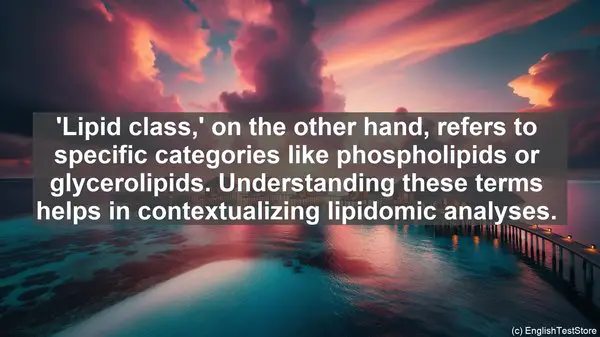Introduction: The Complex World of Lipidomics
Welcome to our lesson on the top 10 commonly confused words in lipidomics. Lipidomics, the study of lipids, is a fascinating and rapidly evolving field. However, it comes with its fair share of complex terminology. Today, we’ll demystify some of the most frequently misunderstood words in this domain.

1. Lipid vs. Fat: Are They the Same?
Often used interchangeably, ‘lipid’ and ‘fat’ have distinct meanings in lipidomics. While all fats are lipids, not all lipids are fats. Lipids encompass a broader range of molecules, including phospholipids, sterols, and more. Fats, on the other hand, specifically refer to triglycerides. So, next time you come across these terms, remember their subtle differences.
2. Sphingolipid vs. Glycolipid: Understanding the Variations
Sphingolipids and glycolipids are two important classes of lipids. Sphingolipids have a sphingosine or sphingoid base, while glycolipids contain a sugar moiety. Both play crucial roles in cell membranes and signaling. Understanding their distinctions is vital for comprehending lipid pathways and functions.
3. Saturation vs. Unsaturation: The Double Bond Dilemma
The terms ‘saturated’ and ‘unsaturated’ refer to the presence or absence of double bonds between carbon atoms in a lipid molecule. Saturated lipids have no double bonds, while unsaturated ones have at least one. This distinction impacts their physical properties, such as melting points, and also influences their biological functions.
4. Isomer vs. Isobar: Not as Similar as They Sound
Isomers and isobars are terms often encountered in lipidomics. Isomers are molecules with the same chemical formula but different structural arrangements. Isobars, on the other hand, have the same mass but differ in their elemental composition. Distinguishing between these terms is crucial for accurate lipid identification and characterization.
5. Lipidomics vs. Metabolomics: Bridging the Gap
Lipidomics and metabolomics are complementary fields. While lipidomics focuses specifically on lipids, metabolomics encompasses a broader range of small molecules. However, lipids are a significant component of the metabolome. Collaborations and integrated approaches between these disciplines are essential for comprehensive biological insights.
6. Annotation vs. Identification: Navigating the Data
In lipidomics, data analysis is a crucial step. ‘Annotation’ refers to assigning putative identities to lipid features based on spectral matching or other criteria. ‘Identification,’ on the other hand, involves confirming the structure through techniques like tandem mass spectrometry. Both processes are integral to extracting meaningful information from lipidomic datasets.

7. Lipidome vs. Lipid Class: From Global to Specific
The ‘lipidome’ refers to the entire lipid complement of a cell, tissue, or organism. It encompasses all lipid classes and their respective molecular species. ‘Lipid class,’ on the other hand, refers to specific categories like phospholipids or glycerolipids. Understanding these terms helps in contextualizing lipidomic analyses.
8. Lipid Bilayer vs. Micelle: Structures in Action
Lipids are known for their ability to form diverse structures. The ‘lipid bilayer’ is a fundamental component of cell membranes, with hydrophilic heads facing outward and hydrophobic tails inward. ‘Micelles,’ on the other hand, are spherical structures formed by lipids in aqueous solutions. Both arrangements have unique properties and biological functions.
9. Lipid Extraction: Choosing the Right Method
Before lipid analysis, extraction is necessary to isolate lipids from complex biological matrices. Various methods, such as Folch extraction or solid-phase extraction, exist. Each has its advantages and limitations. Factors like lipid class of interest, sample size, and downstream analysis requirements influence the choice of extraction method.
10. Lipid Standards: Essential for Quantification
Accurate lipid quantification relies on the use of ‘lipid standards.’ These are well-characterized lipid molecules with known concentrations. By comparing the signal intensities of unknown samples with those of standards, lipid concentrations can be determined. Standards also aid in method validation and quality control, ensuring reliable lipidomic data.
